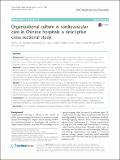Organizational culture in cardiovascular care in Chinese hospitals: a descriptive cross-sectional study

View/
Author
Yin, Emily S.
Downing, Nicholas S.
Li, Xi
Curry, Leslie A.
Li, Jing
Krumholz, Harlan M.
Jiang, Lixin
Note: Order does not necessarily reflect citation order of authors.
Published Version
https://doi.org/10.1186/s12913-015-1211-7Metadata
Show full item recordCitation
Yin, Emily S., Nicholas S. Downing, Xi Li, Sara J. Singer, Leslie A. Curry, Jing Li, Harlan M. Krumholz, and Lixin Jiang. 2015. “Organizational culture in cardiovascular care in Chinese hospitals: a descriptive cross-sectional study.” BMC Health Services Research 15 (1): 569. doi:10.1186/s12913-015-1211-7. http://dx.doi.org/10.1186/s12913-015-1211-7.Abstract
Background: Organizational learning, the process by which a group changes its behavior in response to newly acquired knowledge, is critical to outstanding organizational performance. In hospitals, strong organizational learning culture is linked with improved health outcomes for patients. This study characterizes the organizational learning culture of hospitals in China from the perspective of a cardiology service. Methods: Using a modified Abbreviated Learning Organization Survey (27 questions), we characterized organizational learning culture in a nationally representative sample of 162 Chinese hospitals, selecting 2 individuals involved with cardiovascular care at each hospital. Responses were analyzed at the hospital level by calculating the average of the two responses to each question. Responses were categorized as positive if they were 5+ on a 7-point scale or 4+ on a 5-point scale. Univariate and multiple regression analyses were used to assess the relationship between selected hospital characteristics and perceptions of organizational learning culture. Results: Of the 324 participants invited to take the survey, 316 responded (98 % response rate). Perceptions of organizational learning culture varied among items, among domains, and both among and within hospitals. Overall, the median proportion of positive responses was 82 % (interquartile range = 59 % to 93 %). “Training,” “Performance Monitoring,” and “Leadership that Reinforces Learning” were characterized as the most favorable domains, while “Time for Reflection” was the least favorable. Multiple regression analyses showed that region was the only factor significantly correlated with overall positive response rate. Conclusions: This nationally representative survey demonstrated variation in hospital organizational learning culture among hospitals in China. The variation was not substantially explained by hospital characteristics. Organizational learning culture domains with lower positive response rates reveal important areas for improvement. Electronic supplementary material The online version of this article (doi:10.1186/s12913-015-1211-7) contains supplementary material, which is available to authorized users.Other Sources
http://www.ncbi.nlm.nih.gov/pmc/articles/PMC4685633/pdf/Terms of Use
This article is made available under the terms and conditions applicable to Other Posted Material, as set forth at http://nrs.harvard.edu/urn-3:HUL.InstRepos:dash.current.terms-of-use#LAACitable link to this page
http://nrs.harvard.edu/urn-3:HUL.InstRepos:23993696
Collections
- HMS Scholarly Articles [17922]
- SPH Scholarly Articles [6362]
Contact administrator regarding this item (to report mistakes or request changes)


